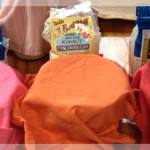
By Margaret Floyd, NTP HHC CHFS
A few weeks ago I got a lovely invitation to appear on the PBS show Healing Quest to demonstrate some traditional food preparation techniques, including how to make properly prepared grains.
Now, we don’t eat a lot of grains at all at the Floyd-Barry household – the odd bowl of oatmeal in the winter, and perhaps some quinoa or rice here and there. (We’ve also become big fans of amaranth lately, but that’s a topic for another post.) But when we do eat grains, they’re most definitely properly prepared.
“Huh?” you might be wondering. What is “properly prepared”?
Here’s the thing about grains: all of them (and all nuts, beans and seeds for that matter) have protective mechanisms to prevent them from breaking down prematurely.
Think about it: the biological imperative of that little grain isn’t to feed us. It’s to create another plant. And it’s in the interest of that grain to stay intact until it’s in the proper environment to do so – warm, dark, moist, a little acidic. In order to protect itself until it’s an appropriate time to sprout, the grain has enzyme inhibitors, natural pesticides (phytates), and other protective mechanisms to prevent it from decomposition. We call these “anti-nutrients” because they have a net negative impact on us when we consume them without neutralizing them – they make digestion very difficult and actually draw from the body’s reserves of minerals in the process. No bueno.
It’s very easy to neutralize these anti-nutrients, however. All we need to do is soak the grains for several hours before cooking them either in water with something a little acidic or a medium like yogurt or buttermilk. Interestingly (and not surprisingly) all traditional cultures had mechanisms for doing this: true sourdough bread or oatmeal that has been soaked overnight are two great examples. The Ethiopian fermented bread, “injera”, is made of teff flour using a similar technique.
When we soak the grain, we’re essentially tricking it into thinking it’s about to grow another plant. It takes down its defenses and we can digest it more readily. For many people who experience digestive distress with grain consumption (bloating, gas, etc), proper preparation can be the solution.
On a teleconference with the inspiring Sally Fallon from the Weston A Price Foundation discussing what recipes I’d be demonstrating for the show, we ticked off the standards (oatmeal, rice) and then she suggested pancakes.
Pancakes!? I can’t remember the last time I had pancakes!

Excited at the challenge I of course set out to practice the recipe in her seminal book: Nourishing Traditions. There are three options of flours to use – spelt, kamut, or whole wheat – and so I decided to do a taste test of the three.
The method is simple: combine the flour with buttermilk and leave it out overnight to soak. In the morning, you whisk in the remaining ingredients (see recipe below), cook them as you would any other pancake, and you have yourself a seriously delicious treat.
To our surprise, we fell in love with the spelt pancakes. Everyone who tasted them preferred them of the three flour types I tried. Spelt can be dense and heavy (which we were expecting), but with proper preparation they were delightfully light, fluffy, and naturally sweet. The kamut pancakes were also yummy – a little like corn cakes and closer to your standard pancakes. The straight up whole wheat were the most disappointing of the bunch.
Curious to run your own taste test? Here’s the recipe out of Nourishing Traditions. (If you don’t have this cookbook, you should. Go buy it now.)

Pancakes
- 2 cups freshly ground spelt, kamut, or whole wheat flour (our preferred brand is Bob’s Red Mill)
- 2 cups buttermilk, kefir or yogurt (we used buttermilk)
- 2 eggs, lightly beaten
- ½ teaspoon sea salt
- 1 teaspoon baking soda
- 2 tablespoons melted butter
Soak flour in buttermilk, kefir or yogurt in a warm place for 12-24 hours. (Those with milk allergies may use 2 cups filtered water plus 2 tablespoons whey, lemon juice, or vinegar in place of undiluted buttermilk, kefir or yogurt.) Stir in other ingredients and thin to desired consistency with water (MF note: we didn’t need to add any water – our spelt/buttermilk mixture was the perfect consistency). Cook on a hot, oiled griddle or in a cast-iron skillet. These pancakes cook more slowly than either unsoaked whole grain flour or white flour pancakes. The texture will be chewy and the taste pleasantly sour. Serve with melted butter and maple or sorghum syrup, raw honey, berry syrup (recipe in Nourishing Traditions), or apricot butter (recipe in Nourishing Traditions).



You should try buckwheat sometime – that’s our favorite. We also make them the NT way. I think buttermilk is the best thing that can happen in a traditional pancake. 🙂
I had the privilege of taste-testing these properly prepared spelt pancakes with a slab of pastured butter and a touch of pure maple syrup…and they were DELICIOUS! As Margaret said, much different than your traditional pancake. Soaking the grains and using high quality ingredients really does make the difference. I’m not a big pancake eater, but if I decide to have a breakfast treat again, I’d definitely make these! Thanks for showing us how it’s done Margaret 🙂
Great post! Just curious – why do grains need the acid but beans and nuts need water only? If we just soak grains in plain water does it not neutralize the phytase correctly? Also, I usually just soak beans for 8-12 hours; is 12-24 really necessary for grains? I have sprouted wheat grains and then dried them and ground them into flour, but I noticed that my stomach got upset. Could that be because I’m allergic/sensitive to wheat? Or does that somehow alter the grain into something else (like diastatic malt) that makes it unsuitable for bread? Thanks for any info/insight you can provide!